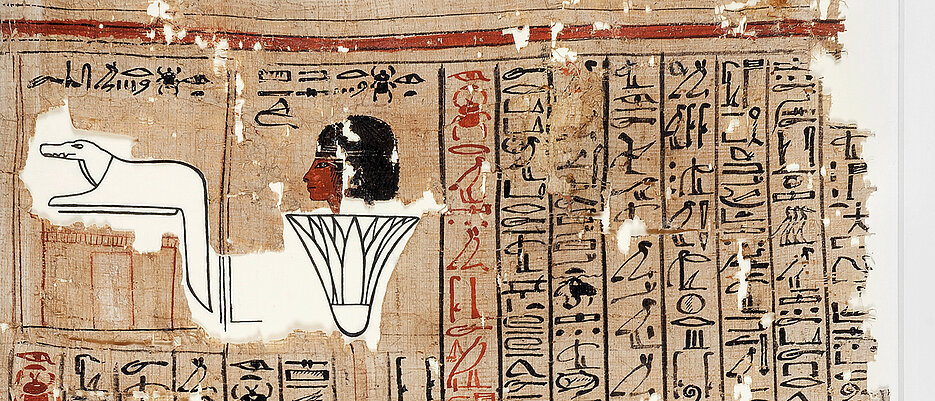The Egyptian Book of the Dead provides unique insights into the religious life of ancient Egypt. A new handbook presents the current state of research. Co-editor is the Würzburg Egyptologist Martin Andreas Stadler.

The path to “paradise” is open to people who have led a pious life free of sins. With a clear conscience, they can recite the “negative confession of sins” after their death before 42 judges of the dead: 42 times they negate having committed 42 different sins such as murder, theft, adultery, cultic impurity.
Anubis, the god of embalming, then weighs their heart. If the heart is as light as a feather on the other side of the scale, the dead person may live forever. A sinful person’s destiny is quite different. If his heart is too heavy because of his sins, the devourer comes and annihilates the sinner. As a shadow, he is thus excluded from further existence.
Publication by Oxford University Press
At least that is what we read in the Book of the Dead-a collection of Egyptian texts on papyri or mummy bandages that were given to distinguished deceased persons in their graves from the New Kingdom onwards (1540 to 1075 BC). The Book of the Dead is the focus of a new handbook now published by Oxford University Press. The editors are Professor Martin Andreas Stadler, Chair of Egyptology at the Julius Maximilian University of Würzburg (JMU), and Rita Lucarelli, Associate Professor of Egyptology at the University of California, Berkeley.
“Among the broad spectrum of ancient Egyptian religious literature, the Book of the Dead is the most representative work for the study of the ancient Egyptian mortuary religion as well as the magical and ritual practices associated with it,” explains Martin Andreas Stadler. Its rich corpus of texts and images, he says, provides unique information about the practices of scribes, the religion of the dead, myths and priestly rituals in ancient Egypt from the second millennium to the second century BCE. The Book of the Dead was thus itself an important manual for Egyptians with magical knowledge to help them master the difficult and dangerous path to the afterlife.
No Book of the Dead is like the other
However, anyone who wants to study the Book of the Dead is not only confronted with an extensive research literature dating back almost 200 years but is also literally overwhelmed by the sheer mass of surviving textual evidence. “No two books of the dead are alike. That’s just the way it is in a manuscript tradition,” says Stadler.
Over the almost 2,000 years, the reception has also changed. “We can observe how even the Ancient Egyptians no longer understood some words at some point and then replaced them with new ones that perhaps gave the text a completely different meaning, sometimes also established new myth traditions,” says Stadler. That is why it is “immensely complex” to deal with the ancient Egyptian Book of the Dead.
First comprehensive orientation in the thicket of secret knowledge
This is where the new handbook comes in. In five parts, comprising 28 chapters, the new handbook presents the current state of research on the Book of the Dead. Twenty-five scholars from ten countries explain, among other things, the history of the text, the types of sources, the position of the Book of the Dead in ancient Egyptian religion, special aspects of its content and its reception in modern times. The Oxford Handbook of the Ancient Egyptian Book of the Dead is thus the first major handbook to collect and synthesise the wide-ranging scholarship on the Book of the Dead as well as the broader literature on ancient Egyptian religion and magic.
“This collection of contributions by experts will be useful for both curious students and experienced scholars, including those from neighbouring disciplines,” Martin Andreas Stadler and Rita Lucarelli are certain. In their opinion, the handbook will become an important tool for any research on the Book of the Dead in the coming years.
The editors
Martin Andreas Stadler was appointed Heisenberg Professor of Ancient Egyptian Cultural History in the Ptolemaic-Roman Period at the University of Würzburg in 2011. He is full professor of Egyptology there since then. He taught as a acting professor at the University of Tübingen in 2009/10 and was a visiting professor in Paris in 2015. His research focuses on Egyptian funerary art, demotic literature and Egyptian religion, including the Ptolemaic-Roman period. In particular, he explores the question of whether and how Egyptians preserved their cultural identity during the period of Greek and Roman rule.
Rita Lucarelli is associate professor of Egyptology at the University of California Berkeley and curator of Egyptology at the Phoebe A. Hearst Museum of Anthropology in Berkeley. She worked as a research fellow and lecturer at the Institute of Egyptology at the University of Bonn, where she was part of the team of the “Book of the Dead Project” of the North Rhine-Westphalian Academy of Sciences. She is currently working on a project to create 3D models of ancient Egyptian coffins, the “Book of the Dead in 3D”.
The Oxford Handbook of the Egyptian Book of the Dead. Edited by Rita Lucarelli and Martin Andreas Stadler. 616 pages | 200 illustrations, 5 tables. ISBN: 9780190210007







